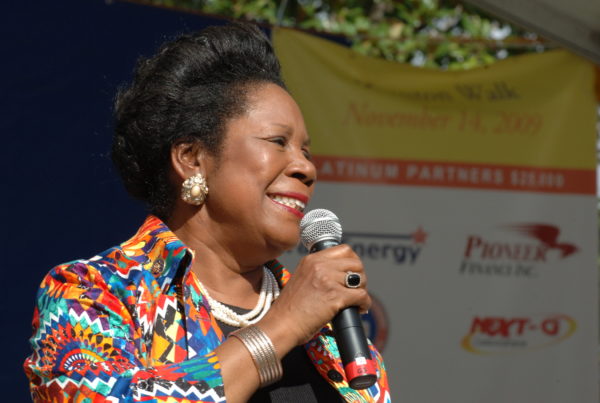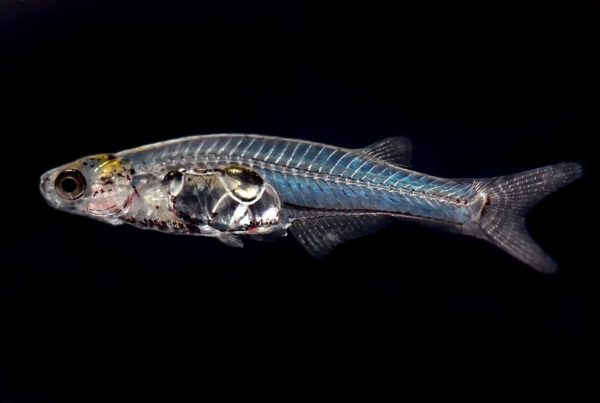From Marfa Public Radio:
Ashley Watt has been thinking about death a lot lately. The death of her mother, the death of her cattle and how things end in the oil patch.
“No one wants to discuss when it looks like when an oil well or an oil field dies,” Watt said, sitting in her home on her 22,000-acre ranch in Crane County.
She hadn’t really thought about it before either. But over the last year, she’s come face-to-face with a long list of problems spawned from the aging oilfield dotting the horizon of her property.
It was a bright July day when we first met and the 35-year-old gave me a tour of the land. We were looking for an oil spill that had become part of the landscape.
“Here’s some of it on the left and there’s another one over that hill,” she said.
As we pushed through scrub brush, an acrid smell filled the air. Then, Watt pointed out a large black glob. “It is crude oil basically mixed with sand and just dried over time to create an oil-sandstone.”
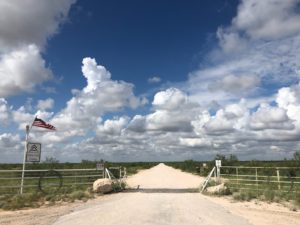
Watt grew up on her ranch that spans thousands of acres in Crane County where her family raised a herd of about 600 cattle until recently.
Mitch Borden / Marfa Public Radio
Corroding debris from companies lined her dirt roads. Pumpjacks, pipelines emerged from the ground. And dead mesquite leftover from past accidents filled the scenery where cows should be grazing.
One after another, Watt pointed out scars left from the industry — sometimes pulling out a drone to get a better look at the landscape.
“You want to see a gas leak before it’s treated…It’s like literally just a dead circle where everything is dead.”
Walking up to an exposed pool of crude, Watt spotted something. “Oh here’s a dead bird. Look on the other side, laying right in there.”
It’s a distressing sight, but Watt said it’s nothing compared to the existential threat a nearly 70-year-old oil well called “Estes #24” is causing her.
The well was acquired by Chevron decades ago and by 1995 the oil company plugged and abandoned the Estes, filling it with cement to prevent it from leaking. But in early June, the well was discovered spewing toxic water believed to be from past oil production.
“With the Estes #24 blowing out at the surface, that’s pretty much been my life,” Watt said.
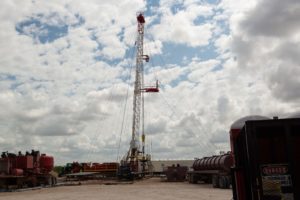
Chevron brought in workers to drill out and replug the Estes #24 which was an ongoing process that took practically all summer.
Mitch Borden / Marfa Public Radio
As her team of hired experts assessed the damage and potential impacts to her land, Watt said her biggest concern is the Estes contaminating the groundwater she, her family and livestock drink.
“We generally don’t test our water out here. Why do we need it?” she explained, “It’s just well-water and it should be safe.”
Crews arrived to dig out the Estes and plug the leak, drilling rigs towered over the desert. Watt moved hundreds of cattle off her ranch, finding some dead. While all this was happening, she said she couldn’t help but think about past incidents, signs that could indicate her drinking water was contaminated.
Watt remembered her mother who had suddenly died from a rare type of cancer a few years ago. Could that have been caused by chemicals from the oil field reaching their drinking water? When did all these problems start? She had her suspicions but no hard proof.
More and more Watt began to have a lot of questions: “What have we been drinking?” and “What have I consumed?”
Catie Matthews, a spokesperson for Chevron thinks these concerns are misplaced.
“Simply put there’s nothing to suggest at this point in time that the aquifer is contaminated,” said Matthews.
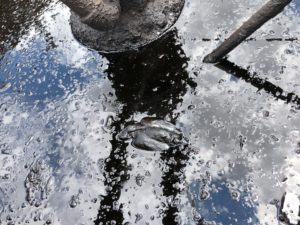
Watt has had to pull dead wildlife out of multiples pools of crude left open at the base of pumpjacks — like this dead bird.
Mitch Borden / Marfa Public Radio
While Watt and her team believe there could be more leaks happening underground that aren’t being caught, Matthews said water samples taken from a fresh water well showed Benzene and other chemicals found in oil production were within safe drinking limits.
“I would just hope that people are following the facts, not the claims, the facts,” Matthews said.
It took nearly three months, but Chevron was able to re-plug the Estes in early September.
In that time, Watt took to Twitter to air out her frustrations with the oil giant and post her theories on what caused the Estes — and at least one other oil well — to leak. Essentially, Watt’s team believes injected water from oil production has increased pressure underneath her land and is causing old wells to leak above and potentially below ground.
Matthews said Chevron won’t speculate on what caused the Estes to leak, but insists the company has done right by Watt. For instance, the company provided drinking water to Watt for months and held regular briefings with her and her staff on the situation.
“The work was to stop the flow at the surface and re-plug the well and we’ve done both of those things,” she said. “Any other concerns Ms. Watt would address with the Texas Railroad Commission.”

Watt drives around her ranch with a drone she flys to see if she can find any new signs of oil or gas spills.
Mitch Borden / Marfa Public Radio
The Texas Railroad Commission, the confusingly named oil and gas regulator for the state, has been investigating the Estes along with other issues across Watt’s property, where dozens of oil and gas companies have left their mark for decades.
One of the agency’s core tenets, according to a spokesperson, is the “protection of public safety and the environment.” But critics of the regulator, like Virginia Palacios, question how good the agency is at doing its job. Palacios is the executive director of Commission Shift, a nonprofit dedicated to holding the railroad commission accountable.
“I don’t think we have a system we can trust right now,” she lamented.
According to Palacios, the state’s oil and gas regulator has serious problems ranging from conflicts of interest among top officials to reacting slowly to industry violations. In some cases, it’s taken years for the agency to resolve situations concerning pollution stemming from oil and gas production.
“I see people asking for help from the railroad commission and not getting it,” Palacios said. “Landowners are sitting here, community members are sitting here kind of waiting for justice, experiencing health impacts and it isn’t fair.”
According to Palacios, all of that makes it hard to believe that the railroad commission is effective at protecting Texans from the oil and gas industry.
These worries though didn’t stop Watt from appearing before the commission during a public meeting on Sept. 29 to plead her case.
“This entire incident has been absolutely embarrassing for us as a state,” Watt told the commission. “The oil and gas industry can not be allowed to permanently destroy the lands and waters of West Texas.”

Mitch Borden / Marfa Public Radio
It wasn’t her first time in front of the agency. Watt had previously presented her team’s evidence indicating toxic water from the oil field could be flowing into multiple aquifers under her land — and there’s reason to believe the subsurface pressure that caused the Estes to erupt with toxic water will cause other abandoned oil wells to spring back to life.
Watt asked the state to have Chevron drill groundwater monitoring wells and, if needed, have Chevron clean up the damage to her water and property. Jim Wright, one of the three officials leading the railroad commission, responded to Watt.
“I’m trying to study everything about your situation and you have my commitment within the law that things are done correctly,” Wright said during the nearly hour meeting.
A few days later the commission ignored Watt’s request, approving Chevron’s plan to take soil samples to assess the degree of pollution left from the Estes, which still needs to be cleaned up.
It’s not the outcome Watt was looking for, but she’s planning on meeting with Chevron later this month. If the company doesn’t agree to her proposal, then she’s ready to spend thousands to drill the monitoring wells herself and even go to court.
“If I just wanted money I would not be speaking to you. I would have shut up,” she said. “And I would have attorneys on this and we would be negotiating and trying to get money out of this. That’s not my goal. My goal is just to get this land cleaned up.”
There are five stages of grief, and when I first met Watt she was angry. But now, as months have passed, she said she’s reached a level of “dejected acceptance.”
Thinking back to when she drove me around her land, the idea that she’s grieving makes a lot of sense.
“My legacy is tied to this land,” she said.
Watt will tell you how her family has been in the Permian Basin since before oil was first struck in the 1920s, which is part of why she said this experience has been so hard for her.
“This is where all my childhood memories are. This is where I scattered my mom’s ashes, my dad’s ashes. There’s literally blood and sweat and tears that are in this.”
All Watt wants is to go back to raising cattle and enjoying her land. But that won’t be possible until she knows her water is safe to drink. That may take a while, but Watt is prepared to do whatever she can to make sure she has a long life on her ranch.




